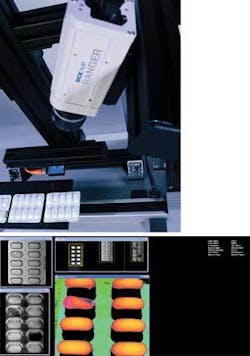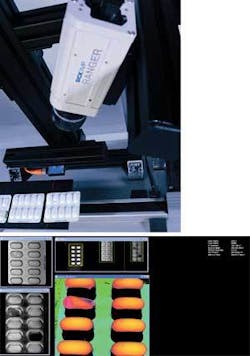3-D profiling makes drug inspection easy
Andrew Wilson, Editor, [email protected]
In the pharmaceutical industry nonprescription drugs are often packaged in blister packs that, once opened, cannot be reclosed. This packaging makes it easy for consumers to discern whether a package has already been opened or, in the case of some drugs, whether the consumer is following the proper drug regimen.
The packaging is made up of a molded PVC base with raised areas called “blisters” that contain the medication. Once the drugs have been inserted into the blisters, the package is covered with a foil laminate. Consumers remove the tablets by either breaking the blisters or by peeling away the laminate foil strip. In filling and sealing these packages, drug companies often need to detect whether any of the blisters are dented, damaged, or broken and whether a single tablet is present within each blister. To address this problem, Matthias Johannesson, a senior technology specialist in the research and development department at SICK IVP (Linköping, Sweden; www.sickivp.com) has developed a structured-laser light system that can perform both tasks relatively simply and easily.
“In the development of the system,” says Johannesson, “we realized that it would need to display the profile of the blister pack and to highlight the contents within each blister.” To accomplish profile measurement, blister packs moving along a conveyor belt are illuminated with an SNF structured-light laserfrom StockerYale (Salem, NH, USA; www.stockeryale.com) mounted off-axis from the normal of the conveyor belt. Reflected laser light is acquired and processed by SICK’s Ranger E50 multiscan camera-a Gigabit Ethernet-based version of the company’s Ranger camera. “Because the laser light illuminates the blister pack off-axis from the camera,” says Johannesson, reflected light will represent the line profile of the blister pack.
The camera’s 512 × 1536 CMOS sensor generates a three-dimensional height image of the blister pack that is determined by computing the centroid of the laser line at each point along the profile. Once computed using the camera’s on-board processor, this image is transferred over Gigabit Ethernet for display on a PC monitor (see figure).
“While the profile measurement can determine whether a blister pack is dented, damaged, or broken,” says Johannesson, “it cannot be used to highlight the presence or absence of drugs within.” For this, a second laser line light, also from StockerYale, is mounted in the same plane as the camera. “When this laser line illuminates the blister pack,” says Johannesson, “reflected light cannot determine its 3-D profile. However, because this light will be both absorbed and scattered in different ways, it can determine whether a drug is present or absent.
To detect damage or absence of drugs within opaque PVC blister packs, SICK IVP has developed a structured laser light system using the company’s Ranger E50 camera. While an off-axis laser creates a 3-D height map of the blister pack and detects damage, light from a laser on-axis with the camera measures spectral reflectivity that determines the presence or absence of a drug.
This reflected laser light also is processed by the Ranger E50 camera. The reflected properties of this line light are not a representation of the height of the blister pack, but a measure of spectral reflectivity. By computing the rate of relative spread from the center of the laser line of this reflected line light, an image of the blister pack can be produced that will highlight whether a drug is present.
“It is extremely difficult for the human eye to discern presence or absence of drugs within blister packs,” commented Karl Gunnarsson, SICK USA vision business-development manager. “Even with very sophisticated LED lighting, high-resolution cameras, and sophisticated software, such tasks may prove very difficult, especially under factory lighting conditions. However, by integrating structured lighting and smart cameras, it is possible to discern both blister-pack damage and the presence and absence of tablets within using a single structured lighting system.”

